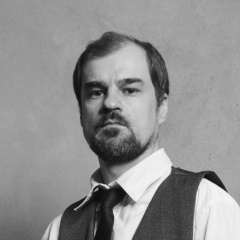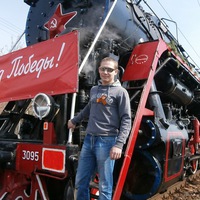"Проезжаю я зловещие места там, где человек – главное богатство недр"
23 февраля с [id165862|товарищем Михаилом] устроили бросок под Кириши в Погостье. С января по апрель 1942 года у этого маленького поселка шли ожесточенные бои по прорыву блокады Ленинграда. Советские и немецкие войска несли большие потери, а многодневное противостояние за обладание железнодорожной насыпью (линия немецкой обороны) стало символом бесплодной, но кровавой борьбы. К весне 54 армия смогла взломать оборону немцев, но успех оказался запоздалым - 2 Ударная южнее уже погибла в окружении, а вести бои весной на болотах было невозможно. Местность здесь безлюдная, насыпь с обеих сторон окружают леса и болота. Людей почти нет. Сегодня Погостье полузаброшенная деревня с несколькими жителями. Мертвых здесь намного больше, чем живых.
Взяв распечатки современной топографической, а также советских и немецких карт 1942 года, термос чая, флягу Егермейстера мы решили выйти к современной просеке, идущей параллельно железной дороге. Обходя деревню восточнее мы сразу же столкнулись с проблемой отсутствия хоть каких-либо тропинок, большим количеством оврагов и каналов, идти дальше было невозможно. Справа виднелось воинское кладбище с красным флагом и церковью, но овраги и река Мга не позволяли свернуть. Пришлось возвращаться к насыпи и по мосту переходить реку. К слову, о насыпи... Она мне представлялась более высокой и неприступной. Но в условиях боев, когда атакующие попадали под огонь, установленных в дзотах насыпи, немецких пулеметов и артиллерии даже такой рубеж становился непроходимым без помощи саперов и танков. Пешком там воевать предельно трудно. Пройдя даже 10 минут по снежной целине можно понять почему часто продвижение войск под огнем было 200-500 метров. Иногда ноги проваливались по колено в снег. Кладбище с церковкой и стягом почти все занесено снегом, но все равно производит сильное впечатление. Еще один воинский погост, как понимаю, находится севернее станции.
Выйдя на просеку надо было решить - куда мы хотим идти. На западе было место знаменитого "лесного городка" немцев, блиндажи которого были раздавлены в ходе атаки танков КВ-1. На востоке был проход к высоте 55. В этом месте три недели несколько частей советской 11 стрелковой дивизии в голодном состоянии держали круговую оборону в окружении, нарушая снабжение немцев. Решили идти к высотке и углубляться в абсолютно тихий и безмятежный заснеженный лес, ориентируясь по картам и навигатору. К опушке возле высоты мы вышли, а вот саму высоту так и не нашли, повернув на север, чтобы выйти к насыпи до темноты. В лесу просто невозможно понять где есть возвышенности. При этом сам заснеженный рельеф опушки намекал, что здесь сохранились следы окопов. Начало попадаться много поваленных деревьев и стволов с круглыми следами, как будто от попадания пуль. Попадался и заржавелый металлолом: щитки, лопатки и части механизмов. Непонятно, остались они после 1942 года или это современные следы от поисковиков. В сумерках вернулись на станцию и уже в темноте ждали последнюю электричку на Петербург.
Собственными ногами оценили возможности пешей войны в снегах и болотах и "цену одного километра". Надо бы вернуться уже летом и с опытными людьми, исследующими эти места.
Ниже альбом с самыми удачными фотографиями.
23 февраля с [id165862|товарищем Михаилом] устроили бросок под Кириши в Погостье. С января по апрель 1942 года у этого маленького поселка шли ожесточенные бои по прорыву блокады Ленинграда. Советские и немецкие войска несли большие потери, а многодневное противостояние за обладание железнодорожной насыпью (линия немецкой обороны) стало символом бесплодной, но кровавой борьбы. К весне 54 армия смогла взломать оборону немцев, но успех оказался запоздалым - 2 Ударная южнее уже погибла в окружении, а вести бои весной на болотах было невозможно. Местность здесь безлюдная, насыпь с обеих сторон окружают леса и болота. Людей почти нет. Сегодня Погостье полузаброшенная деревня с несколькими жителями. Мертвых здесь намного больше, чем живых.
Взяв распечатки современной топографической, а также советских и немецких карт 1942 года, термос чая, флягу Егермейстера мы решили выйти к современной просеке, идущей параллельно железной дороге. Обходя деревню восточнее мы сразу же столкнулись с проблемой отсутствия хоть каких-либо тропинок, большим количеством оврагов и каналов, идти дальше было невозможно. Справа виднелось воинское кладбище с красным флагом и церковью, но овраги и река Мга не позволяли свернуть. Пришлось возвращаться к насыпи и по мосту переходить реку. К слову, о насыпи... Она мне представлялась более высокой и неприступной. Но в условиях боев, когда атакующие попадали под огонь, установленных в дзотах насыпи, немецких пулеметов и артиллерии даже такой рубеж становился непроходимым без помощи саперов и танков. Пешком там воевать предельно трудно. Пройдя даже 10 минут по снежной целине можно понять почему часто продвижение войск под огнем было 200-500 метров. Иногда ноги проваливались по колено в снег. Кладбище с церковкой и стягом почти все занесено снегом, но все равно производит сильное впечатление. Еще один воинский погост, как понимаю, находится севернее станции.
Выйдя на просеку надо было решить - куда мы хотим идти. На западе было место знаменитого "лесного городка" немцев, блиндажи которого были раздавлены в ходе атаки танков КВ-1. На востоке был проход к высоте 55. В этом месте три недели несколько частей советской 11 стрелковой дивизии в голодном состоянии держали круговую оборону в окружении, нарушая снабжение немцев. Решили идти к высотке и углубляться в абсолютно тихий и безмятежный заснеженный лес, ориентируясь по картам и навигатору. К опушке возле высоты мы вышли, а вот саму высоту так и не нашли, повернув на север, чтобы выйти к насыпи до темноты. В лесу просто невозможно понять где есть возвышенности. При этом сам заснеженный рельеф опушки намекал, что здесь сохранились следы окопов. Начало попадаться много поваленных деревьев и стволов с круглыми следами, как будто от попадания пуль. Попадался и заржавелый металлолом: щитки, лопатки и части механизмов. Непонятно, остались они после 1942 года или это современные следы от поисковиков. В сумерках вернулись на станцию и уже в темноте ждали последнюю электричку на Петербург.
Собственными ногами оценили возможности пешей войны в снегах и болотах и "цену одного километра". Надо бы вернуться уже летом и с опытными людьми, исследующими эти места.
Ниже альбом с самыми удачными фотографиями.
"I drive through ominous places where man is the main wealth of the bowels"
February 23 with [id165862 | Comrade Michael] staged a throw near Kirishi in Pogost. From January to April 1942, fierce battles broke through this small village to break through the blockade of Leningrad. Soviet and German troops suffered heavy losses, and the multi-day confrontation over the possession of a railway embankment (German defense line) became a symbol of a fruitless but bloody struggle. By the spring of 54, the army was able to break into the German defenses, but success was belated - 2 Impact to the south had already died in the encirclement, and it was impossible to conduct battles in the spring in the swamps. The terrain here is deserted, forests and swamps surround the mound on both sides. There are almost no people. Today Pogoste is a half-abandoned village with several inhabitants. There are many more dead than living.
Taking printouts of modern topographic, as well as Soviet and German maps of 1942, a thermos of tea, a flask of Jägermeister, we decided to go to a modern clearing that runs parallel to the railway. Walking around the village east, we immediately faced with the problem of the absence of at least any paths, a large number of ravines and canals, it was impossible to go further. On the right was a military cemetery with a red flag and a church, but the ravines and the river Mga were not allowed to collapse. I had to go back to the embankment and cross the river over the bridge. By the way, about the embankment ... It seemed to me higher and impregnable. But in the conditions of battles, when the attackers came under fire, installed in the bunkers of the embankment, German machine guns and artillery, even such a line became impassable without the help of sappers and tanks. Walking there is extremely difficult. After going even 10 minutes on the virgin snow, you can understand why often the advance of troops under fire was 200-500 meters. Sometimes the legs fell knee-deep in the snow. A cemetery with a church and a banner almost all covered with snow, but still makes a strong impression. Another military graveyard, as I understand it, is located north of the station.
Having gone to the clearing, it was necessary to decide where we want to go. In the west there was a place of the famous "forest town" of the Germans, whose dugouts were crushed during the attack of the KV-1 tanks. In the east, there was a passage to an altitude of 55. At this point, for several weeks, several units of the Soviet 11th Infantry Division were in a hungry state, holding a circular defense surrounded, disrupting the German supply. We decided to go to the skyscraper and go deep into an absolutely quiet and serene snowy forest, guided by maps and a navigator. We went to the edge near the height, but we did not find the height itself, turning north to go to the embankment before dark. In the forest, it is simply impossible to understand where there are hills. At the same time, the snow-covered relief of the edge itself hinted that traces of trenches were preserved here. A lot of fallen trees and trunks began to come across with round tracks, as if from a bullet. I also came across rusted scrap metal: shields, blades and parts of mechanisms. It is not clear whether they remained after 1942 or whether these are modern traces from search engines. At dusk they returned to the station and already in the dark they were waiting for the last train to St. Petersburg.
They evaluated with their own feet the possibilities of a pedestrian war in the snow and swamps and the "price of one kilometer". We should return in the summer with experienced people exploring these places.
Below is an album with the most successful photos.
February 23 with [id165862 | Comrade Michael] staged a throw near Kirishi in Pogost. From January to April 1942, fierce battles broke through this small village to break through the blockade of Leningrad. Soviet and German troops suffered heavy losses, and the multi-day confrontation over the possession of a railway embankment (German defense line) became a symbol of a fruitless but bloody struggle. By the spring of 54, the army was able to break into the German defenses, but success was belated - 2 Impact to the south had already died in the encirclement, and it was impossible to conduct battles in the spring in the swamps. The terrain here is deserted, forests and swamps surround the mound on both sides. There are almost no people. Today Pogoste is a half-abandoned village with several inhabitants. There are many more dead than living.
Taking printouts of modern topographic, as well as Soviet and German maps of 1942, a thermos of tea, a flask of Jägermeister, we decided to go to a modern clearing that runs parallel to the railway. Walking around the village east, we immediately faced with the problem of the absence of at least any paths, a large number of ravines and canals, it was impossible to go further. On the right was a military cemetery with a red flag and a church, but the ravines and the river Mga were not allowed to collapse. I had to go back to the embankment and cross the river over the bridge. By the way, about the embankment ... It seemed to me higher and impregnable. But in the conditions of battles, when the attackers came under fire, installed in the bunkers of the embankment, German machine guns and artillery, even such a line became impassable without the help of sappers and tanks. Walking there is extremely difficult. After going even 10 minutes on the virgin snow, you can understand why often the advance of troops under fire was 200-500 meters. Sometimes the legs fell knee-deep in the snow. A cemetery with a church and a banner almost all covered with snow, but still makes a strong impression. Another military graveyard, as I understand it, is located north of the station.
Having gone to the clearing, it was necessary to decide where we want to go. In the west there was a place of the famous "forest town" of the Germans, whose dugouts were crushed during the attack of the KV-1 tanks. In the east, there was a passage to an altitude of 55. At this point, for several weeks, several units of the Soviet 11th Infantry Division were in a hungry state, holding a circular defense surrounded, disrupting the German supply. We decided to go to the skyscraper and go deep into an absolutely quiet and serene snowy forest, guided by maps and a navigator. We went to the edge near the height, but we did not find the height itself, turning north to go to the embankment before dark. In the forest, it is simply impossible to understand where there are hills. At the same time, the snow-covered relief of the edge itself hinted that traces of trenches were preserved here. A lot of fallen trees and trunks began to come across with round tracks, as if from a bullet. I also came across rusted scrap metal: shields, blades and parts of mechanisms. It is not clear whether they remained after 1942 or whether these are modern traces from search engines. At dusk they returned to the station and already in the dark they were waiting for the last train to St. Petersburg.
They evaluated with their own feet the possibilities of a pedestrian war in the snow and swamps and the "price of one kilometer". We should return in the summer with experienced people exploring these places.
Below is an album with the most successful photos.








У записи 50 лайков,
3 репостов,
2994 просмотров.
3 репостов,
2994 просмотров.
Эту запись оставил(а) на своей стене Константин Макаров







































































